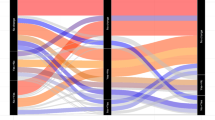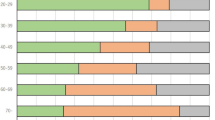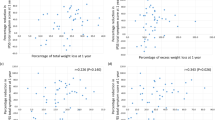Abstract
Background
To evaluate the relationship between cigarette smoking, metabolic syndrome (MetS) and nocturia in patients with lower urinary tract symptoms (LUTS) and benign prostatic enlargement (BPE).
Methods
From 2009 onward, a consecutive series of patients with LUTS/BPE were enrolled. Symptoms were assessed using the International Prostate Symptom Score (IPSS). Age, body mass index (BMI), smoker status, prostate volume (PV), prostate-specific antigen (PSA) levels, fasting glucose levels, triglyceride levels, and high-density lipoprotein levels were recorded. MetS was defined according to Adult Treatment Panel III criteria. Moderate/severe nocturia was defined as nocturnal micturition episodes ≥2.
Results
Overall 492 patients were enrolled with median age and BMI of 68 years (IQR 61/74) and 26.5 kg/m2 (IQR: 24/29), respectively. Moderate/severe nocturia was reported in 212 (43.1%) patients. MetS was diagnosed in 147 (29.9%) patients and out of them 89 (60.5%) complained moderate/severe nocturia (p = 0.001). Overall 187 (38%) patients were current smokers and out of them 99 (52%) presented moderate/severe nocturia(p = 0.034). Patients with moderate/severe nocturia were older (p = 0.001) and with larger prostate volume (p = 0.003). On multivariate analysis, age (OR: 1.067 per year, 95% CI: 1.036–1.098; p = 0.001), PV (OR: 1.011 per ml, 95% CI: 1.003–1.019; p = 0.006), MetS (OR: 2.509, 95% CI: 1.571–4.007; p = 0.001) and smoking (OR: 1.690, 95% CI: 1.061–2.693; p = 0.027) were associated with nocturia severity.
Conclusions
MetS and smoking doubled the risk of moderate/severe nocturia in patients with LUTS and BPE. Assessing smoking and metabolic status in LUTS/ BPE patients is suggested.
This is a preview of subscription content, access via your institution
Access options
Subscribe to this journal
Receive 4 print issues and online access
$259.00 per year
only $64.75 per issue
Buy this article
- Purchase on Springer Link
- Instant access to full article PDF
Prices may be subject to local taxes which are calculated during checkout
Similar content being viewed by others
References
JLHR Bosch, Everaert K, Weiss JP, Hashim H, Rahnama’i MS, Goessaert A-S, et al. Would a new definition and classification of nocturia and nocturnal polyuria improve our management of patients? ICI-RS 2014. Neurourol Urodyn. 2016;35:283–7.
Bower WF, Whishaw DM, Khan F. Nocturia as a marker of poor health: causal associations to inform care. Neurourol Urodyn. 2016; https://doi.org/10.1002/nau.23000.
Shiri R, Hakama M, Häkkinen J, Auvinen A, Huhtala H, Tammela TLJ, et al. The effects of lifestyle factors on the incidence of Nocturia. J Urol. 2008;180:2059–62.
Kim SY, Bang W, Kim M-S, Park B, Kim J-H, Choi HG. Nocturia is associated with slipping and falling. PLoS ONE. 2017;12:e0169690.
Cornu J-N, Abrams P, Chapple CR, Dmochowski RR, Lemack GE, Michel MC, et al A contemporary assessment of Nocturia: definition, epidemiology, pathophysiology, and management—a systematic review and meta-analysis. Eur Urol. 2012;62:877–90.
FitzGerald MP, Litman HJ, Link CL, McKinlay JB. The association of nocturia with cardiac disease, diabetes, body mass index, age and diuretic use: results from the BACH survey. J Urol. 2007;177:1385–9.
Tikkinen KAO, Auvinen A, Huhtala H, Tammela TLJ, Nocturia and obesity: a population-based study in Finland. Am J Epidemiol. 2006;163:1003–11
de Oliveira MCE, Varella LRD, Angelo PHM, Micussi MTABC. The relationship between the presence of lower urinary tract symptoms and waist circumference. Diabetes Metab Syndr Obes. 2016;9:207–11.
Furukawa S, Sakai T, Niiya T, Miyaoka H, Miyake T, Yamamoto S, et al. Microvascular complications and prevalence of Nocturia in Japanese Patients with type 2 diabetes Mellitus: The Dogo Study. Urology. 2016;93:147–151.
Yoshimura K, Terada N, Matsui Y, Terai A, Kinukawa N, Arai Y. Prevalence of and risk factors for nocturia: analysis of a health screening program. Int J Urol. 2004;11:282–7.
Third Report of the National Cholesterol Education Program (NCEP) Expert Panel on Detection, Evaluation, and Treatment of High Blood Cholesterol in Adults (Adult Treatment Panel III) final report. Circulation 2002; 106: 3143–421.
De Nunzio C, Freedland SJ, Miano R, Trucchi A, Cantiani A, Carluccini A, et al. Metabolic syndrome is associated with high grade gleason score when prostate cancer is diagnosed on biopsy. Prostate. 2011;71:1492–8.
Mattiasson A, Abrams P, Van Kerrebroeck P, Walter S, Weiss J. Efficacy of desmopressin in the treatment of nocturia: a double-blind placebo-controlled study in men. BJU Int. 2002;89:855–62.
Nakagawa H, Niu K, Hozawa A, Ikeda Y, Kaiho Y, Ohmori-Matsuda K, et al. Impact of nocturia on bone fracture and mortality in older individuals: a Japanese longitudinal cohort study. J Urol. 2010;184:1413–8.
Murphy AB, Akereyeni F, Nyame YA, Guy MC, Martin IK, Hollowell CMP, et al. Smoking and prostate cancer in a multi-ethnic cohort. Prostate. 2013;73:1518–28.
Zumrutbas AE, Bozkurt AI, Alkis O, Toktas C, Cetinel B, Aybek Z. The prevalence of Nocturia and Nocturnal Polyuria: can new Cutoff values be suggested according to age and sex? Int Neurourol J. 2016;20:304–310.
Lopes Mendes AL, Decalf V, Denys MA, Tubaro A, Everaert K. The impact of nocturnal polyuria in older people with nocturnal LUTS. Minerva Urol Nefrol. 2017;69:377–383.
Rohrmann S, Smit E, Giovannucci E, Platz EA. Association between markers of the metabolic syndrome and lower urinary tract symptoms in the Third National Health and Nutrition Examination Survey (NHANES III). Int J Obes. 2005;29:310–6.
De Nunzio C, Aronson W, Freedland SJ, Giovannucci E, Parsons JK. The correlation between metabolic syndrome and prostatic diseases. Eur Urol. 2012;61:560–70.
De Nunzio C, Andriole G, Thompson I, Freedland S. Smoking and prostate cancer: a systematic review. Eur Urol Focus. 2015;1:28–38.
De Nunzio C, Brassetti A, Gacci M, Finazzi Agrò E, Carini M, Presicce F, et al. Patients with prostatic inflammation undergoing transurethral prostatic resection have a larger early improvement of storage symptoms. Urology. 2015;86:359–65.
Kupelian V, McVary KT, Kaplan SA, Hall SA, Link CL, Aiyer LP, et al. Association of lower urinary tract symptoms and the metabolic syndrome: Results from the Boston area community health survey. J Urol. 2009;182:616–25.
Rohrmann S, Crespo CJ, Weber JR, Smit E, Giovannucci E, Platz EA. Association of cigarette smoking, alcohol consumption and physical activity with lower urinary tract symptoms in older American men: findings from the third National Health And Nutrition Examination Survey. BJU Int. 2005;96:77–82.
Sağlam HS, Gökkaya CS, Salar R, Memiş A, Adsan O. The effects of age, metabolic syndrome, nocturnal polyuria and sleep disorders on nocturia. Adv Clin Exp Med. 2013;22:489–94.
Klein BE, Klein R, Lee KE, Bruskewitz RC. Correlates of urinary symptom scores in men. Am J Public Health. 1999;89:1745–8.
Bing MH, Moller LA, Jennum P, Mortensen S, Lose G. Nocturia and associated morbidity in a Danish population of men and women aged 60-80 years. BJU Int. 2008;102:808–14–5.
Kang D, Andriole GL, Van De Vooren RC, Crawford D, Chia D, Urban DA, et al. Risk behaviours and benign prostatic hyperplasia. BJU Int. 2004;93:1241–5.
Platz EA, Rimm EB, Kawachi I, Colditz GA, Stampfer MJ, Willett WC, et al. Alcohol consumption, cigarette smoking, and risk of benign prostatic hyperplasia. Am J Epidemiol. 1999;149:106–15.
Narkiewicz K, van de Borne PJ, Hausberg M, Cooley RL, Winniford MD, Davison DE, et al. Cigarette smoking increases sympathetic outflow in humans. Circulation. 1998;98:528–34.
Blanker MH, Bohnen AM, Groeneveld FP, Bernsen RM, Prins A, Ruud Bosch JL. Normal voiding patterns and determinants of increased diurnal and nocturnal voiding frequency in elderly men. J Urol. 2000;164:1201–5.
Schneider DL. Insomnia. Safe and effective therapy for sleep problems in the older patient. Geriatrics. 2002;57:24–6.
Pohorecky LA, Effect of ethanol on urine output in rats. Alcohol. 1985;2:659–66
Joseph MA, Harlow SD, Wei JT, Sarma AV, Dunn RL, Taylor JMG, et al. Risk factors for lower urinary tract symptoms in a population-based sample of African-American men. Am J Epidemiol. 2003;157:906–14.
van Haarst EP, Bosch JLHR, Heldeweg EA. The international prostate symptom score overestimates nocturia assessed by frequency-volume charts. J Urol. 2012;188:211–5.
Author information
Authors and Affiliations
Corresponding author
Ethics declarations
Conflict of interests
The authors declare that they have no competing interest.
Rights and permissions
About this article
Cite this article
De Nunzio, C., Brassetti, A., Proietti, F. et al. Metabolic syndrome and smoking are associated with an increased risk of nocturia in male patients with benign prostatic enlargement. Prostate Cancer Prostatic Dis 21, 287–292 (2018). https://doi.org/10.1038/s41391-017-0003-z
Received:
Accepted:
Published:
Issue Date:
DOI: https://doi.org/10.1038/s41391-017-0003-z
This article is cited by
-
Sleep-related disorders and lower urinary tract symptoms in middle-aged and elderly males: a cross-sectional study based on NHANES 2005–2008
Sleep and Breathing (2024)
-
Relationship between cigarette use and prostate cancer risk: what do we know and what should we do?
Prostate Cancer and Prostatic Diseases (2023)
-
Physical activity decreases the risk of cancer reclassification in patients on active surveillance: a multicenter retrospective study
Prostate Cancer and Prostatic Diseases (2021)



